

Home & Community
Rehabilitation Wherever Life Happens
Rehab Without Walls® home and community rehab blends evidence-based therapies with creative uses of the patient’s surroundings – whether at home, school, work, or in their own community.
Providing rehab therapy in a home and community environment offers a huge advantage in treatment. Addressing goals and barriers in real-life settings can increase motivation, lead to more durable outcomes, and reduce the risk of injuries that could lead to rehospitalization.
For over 30-plus years, we’ve served thousands with our home and community rehab programs – and produced proven results that have been published in numerous peer-reviewed medical journals.
When is home and community neuro therapy the right fit?
Home and community neuro therapy is best suited for adults and children who:
- Are medically stable enough to go home.
- Have appropriate support for safe transition to home and/or have limited access to transportation to facility-based programs.
- Will experience a clinical advantage, such as functional goals requiring practice in their own home or community setting.
Our neuro therapy programs are covered by some commercial health insurance and workers’ compensation plans. Medicare does not cover home and community-based rehabilitation.
Learn more about Funding, Insurance and Worker’s Compensation
Typical
Home Health
rehab model
- Medical Model
- Medication certification requiring homebound status
- Intermittent therapy visits 3-6 hours/week
Typical Home Health
vs
RWW Home and Community Rehab
Home & Community
Neuro Rehabilitation
Advantage
- Rehabilitation Model
- Homebound status NOT a barrier to care
- Intense rehab program = 10-25 hours/week with neuro skilled clinicians
Our Approach
It’s quite simply who we are, we believe in removing the walls associated with neuro rehab – including physical, emotional, and environmental – and focusing on:
- Teaching relevant skills in the individual’s environment as opposed to a staged setting.
- Going beyond personal care to real-life experiences like navigating the kitchen, the bathroom, the grocery store and workplace.
- Building the individual’s personal goals into the therapy plan.
Through this program, instead of just learning to prepare a meal, individuals will learn to shop in their local grocery store and use their own kitchen. Rather than simply focusing on grooming skills, they will learn to navigate their own bathrooms safely.
A comprehensive evaluation is conducted by an interdisciplinary team upon admission to assess for and identify safety issues in both the home and local community.
Evaluation of accessibility, emergency preparedness including ability to exit home in event of an emergency, fall risk, equipment needs/ appropriateness of existing equipment, caregiver support and community resource needs are some of the items evaluated. Our evaluation includes understanding our patients cultural beliefs, learning needs, telecommunication abilities and life stressors as these our pivotal to successful treatment and patient outcomes.
A home safety evaluation is an integral part of our approach. Before therapy begins, we’ll conduct a one- to two-hour inspection focused on:
- Fire hazards.
- ADA specifications for wheelchair-bound individuals (ramps, door widths, etc.).
- Whether an individual would be able to exit the house safely.
- Modifications in the bedroom, bathroom and kitchen that could help the individual be more independent.
- Which surfaces, furniture and rugs might be hazardous or act as impediments.
- Whether the stairs can be navigated safely.
- Which adaptive equipment currently in use might need to be upgraded.
- If the outside terrain is safe and navigable.
Care Team
Our expert team will create a individualized therapy plan for each patient in the home and community rehab program that incorporates elements of the individual’s home into therapy. For example, range of motion can come through daily chores; eye-hand coordination from working on the computer; organizational skills from meal planning and grocery shopping.
The home and community rehab care teams is overseen by a physician and led by a clinical coordinator. The clinical coordinator pulls together the right team, ensures that there are no gaps or overlaps in services, facilitates communication, and leads frequent team meetings that include our patient, therapists, patient’s physician and their families as well as other external stakeholders such as case managers, care givers and specialized medical equipment experts.
Our home and community care team may include experts from the following therapy disciplines:
- Physical, Occupational and Speech Therapy
- Recreational Therapy
- Psychology & Neuropsychology
- Nutrition
- Social Work & Counseling
- Clinical Coordination
- Music Therapy
- Vocational Therapy
- Special Education Tutors
